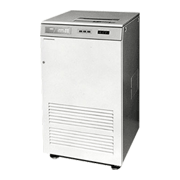In June 1986, Oki Electric Industry announced the OKITACsystem11 Series of office processors. This series had dramatically enhanced distributed processing capabilities and online/network capabilities, and was introduced as a series of high-end versions of the previous OKITACsystem9 series of office computers. The Model 450S was announced at the same time as a low-price model of the OKITACsystem9.
The main features of the OKITACsystem11 Series were as follows:
- (1) Higher performance and capacity
- The Model 1 achieved a processing capacity 3 times that of the Model 750, the top-end machine of the OKITACsystem9 Series (in terms of mips values), and the Model 2 achieved processing capacity 3.8 times that of the Model 750. Main memory capacity was 4 megabytes standard, and ranged up to a maximum of 8 megabytes (Model 2). The system could also be expanded with external memory units -- up to a maximum of four 130 megabyte hard disks, and up to two 1 gigabyte hard disks (in both cases in the Model 2). Thus the system had greatly increased capacity.
- (2) Enabled connection of up to a maximum of 24 workstations
- A maximum of 16 workstations could be connected with the Model 1, and a maximum of 24 workstations with the Model 2. In addition to dedicated workstations, the system could be connected with office computers (OKITACsystem9 Model 350, 450, 450S and 550) and personal computers (if800 Model 60). This made it possible to build a variety of multi-workstation systems and distributed processing systems.
- (3) Support for up to 16 communication lines was standard.
- The standard system supported 8 communication lines for the Model 1 and 16 communication lines for the Model 2. In addition to the BSCIÅ`III transmission protocols, it was also possible to use protocols like SDLC, and the system supported various communication systems ranging from 50 bits/second to 48 kilobits/second.
- (4) Numerous peripheral devices could be used.
- The user could select from three types of printer: a low-price Japanese language printer, a high-speed Japanese language printer and a high-speed Japanese language line printer. It was also possible to use devices such as magnetic tape, and two types of keyboards (JIS layout, sheet slide)
- (5) Inherited CROSII as the basic software (OS)
- These machines inherited CROSII, the OS of the OKITACsystem9 Series, and used CROSIII, which featured enhanced capabilities as a distributed processing system and online/network system. This made it possible to use the numerous application programs of the OKITACsystem9 Series.
- (6) LAN system configuration
- LAN systems could be configured by connecting to the OKINET2000 Model 20 local area network system.
- (7) Realization of a relational database
- Distributed databases
| System | OKITACsystem11 | OKITACsystem9 | ||
|---|---|---|---|---|
| Model | Model 1 | Model 2 | Model 450S | |
| Main memory capacity | Standard | 4MB | 1MB | |
| Maximum | 4MB | 8MB | 2MB | |
| Floppy disk unit | Standard | 8inch 1MBx2 | 5inch 1MB | |
| Expansion | - | 5 or 8inch 1MB | ||
| Magnetic disk unit | Standard | 130MB | 260MB | 20MB |
| Maximum | 260MB | 2.5GB | 20MB | |
| Magnetic tape unit (optional) | Max. x2 (memory density 1600/800BPI, 6250/1600BPI) | Cartridge magnetic tape unit 20MB | ||
| CRT display unit | 14inch, alphanumeric/kana 80char x 25line, kanji display 40char x 25line, colors: selectable from greenish-yellow, green and color (7 colors) | |||
| Keyboard | Selectable from JIS layout or sheet slide system | |||
| Japanese language printer | PRKE type: Kanji 88(176) char/s, alphanumeric/kana 264char/s PRKF type: Kanji 40(80) char/s, alphanumeric/kana 120char/s LPKC type: Kanji 176(230)line/min, alphanumeric/kana 230line/min |
|||
| Workstations (Max.) | 16 | 24 | - | |
| Number of communication lines | 8 lines standard | 16 lines standard | 1line (optional) | |
| Network systems | Distributed processing systems, BSCI-III, SDLC, JCA | Distributed processing systems, LAN,BSCI-III,SDLC,JCA |
Distributed processing systems, BSCI-III | |


